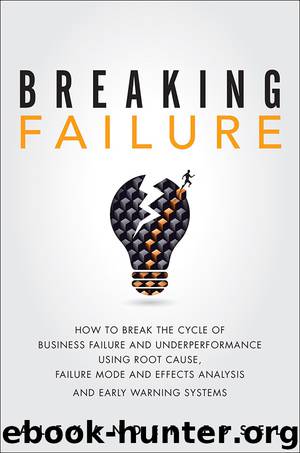Breaking Failure: How to Break the Cycle of Business Failure and Underperformance Using Root Cause, Failure Mode and Effects Analysis, and an Early Warning System by Alexander Edsel

Author:Alexander Edsel
Language: eng
Format: epub
Publisher: Pearson FT Press
Published: 2016-11-20T16:00:00+00:00
Figure 5.4 Example of a typical social media analysis
Now let us see how this measures up against our key business requirement—selling more cars. To do so, we need to add data not originally provided, such as the number of units sold per year in the United States, which is inserted into Figure 5.5 next to one of the social media metrics.
Figure 5.5 Example of a social media analysis that focuses on a key success driver
We should also bring in some consumer behavior considerations into the analysis. For example, is every brand listed a competitor of Toyota? Could it be that in some categories the numbers are skewed due to the fact that most of these social media fans (e.g., Porsche) are neither current nor prospective buyers but rather aspirational car lovers? With 44,000 cars sold per year versus Toyota’s 2.1 million, is imitating Porsche’s social media efforts relevant or useful? For this category, what should instead be done is to find a more relevant competitor such as Honda. Better yet, look at a comparable brand that has improved its social media year after year (i.e., more followers, fans, subscribers, etc.) and determine whether that translated into more cars being sold. If that’s not the case, would such an effort be the best use of your money and effort?
As a matter of fact, many businesses might not realize that in the case of Facebook, less than 2 percent of their posts will appear in the feeds of their fans. Another reality check: One of IBM’s Black Friday e-commerce reports10 highlighted the problem with social media not contributing directly to sales, with less than 1 percent of e-commerce customers who purchased something coming from a social media site. To be fair, it is true that social media gets less credit in part because it is hard to measure what credit a sale should get when someone first hears about the product in social media and buys it several days or weeks later after conducting a Google search. However, a 2013 Gallup poll asked consumers what influence social media had on their purchases, 62 percent of those surveyed said it had no influence, and 30 percent answered “some influence.” The results were only slightly better with Millennials, with 48 percent saying no influence and 43 percent stating it had some influence.11 While social media has a role in creating awareness and interest—at the top of the sales funnel—for small businesses, a better payback might be achieved by simply improving and managing customer review sites. Social media does play a role in search engine optimization, but the benefits in this area have to be measured against the payback and return on investment (ROI) of other alternatives.
Download
This site does not store any files on its server. We only index and link to content provided by other sites. Please contact the content providers to delete copyright contents if any and email us, we'll remove relevant links or contents immediately.
Bad Blood by John Carreyrou(6517)
Rich Dad Poor Dad by Robert T. Kiyosaki(6354)
Principles: Life and Work by Ray Dalio(6170)
Playing to Win_ How Strategy Really Works by A.G. Lafley & Roger L. Martin(5856)
Management Strategies for the Cloud Revolution: How Cloud Computing Is Transforming Business and Why You Can't Afford to Be Left Behind by Charles Babcock(4510)
The Confidence Code by Katty Kay(4172)
Thinking in Bets by Annie Duke(4139)
American Kingpin by Nick Bilton(3735)
Delivering Happiness by Tony Hsieh(3353)
Project Animal Farm: An Accidental Journey into the Secret World of Farming and the Truth About Our Food by Sonia Faruqi(3163)
The Power of Habit by Charles Duhigg(3043)
Brotopia by Emily Chang(2989)
The Tyranny of Metrics by Jerry Z. Muller(2980)
Mastering Bitcoin: Programming the Open Blockchain by Andreas M. Antonopoulos(2964)
The Marketing Plan Handbook: Develop Big-Picture Marketing Plans for Pennies on the Dollar by Robert W. Bly(2950)
I Live in the Future & Here's How It Works by Nick Bilton(2919)
The Content Trap by Bharat Anand(2850)
Applied Empathy by Michael Ventura(2825)
Building a StoryBrand by Donald Miller(2825)
